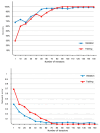Automatic Detection of Acute Leukemia (ALL and AML) Utilizing Customized Deep Graph Convolutional Neural Networks
- PMID: 39061726
- PMCID: PMC11273433
- DOI: 10.3390/bioengineering11070644
Automatic Detection of Acute Leukemia (ALL and AML) Utilizing Customized Deep Graph Convolutional Neural Networks
Abstract
Leukemia is a malignant disease that impacts explicitly the blood cells, leading to life-threatening infections and premature mortality. State-of-the-art machine-enabled technologies and sophisticated deep learning algorithms can assist clinicians in early-stage disease diagnosis. This study introduces an advanced end-to-end approach for the automated diagnosis of acute leukemia classes acute lymphocytic leukemia (ALL) and acute myeloid leukemia (AML). This study gathered a complete database of 44 patients, comprising 670 ALL and AML images. The proposed deep model's architecture consisted of a fusion of graph theory and convolutional neural network (CNN), with six graph Conv layers and a Softmax layer. The proposed deep model achieved a classification accuracy of 99% and a kappa coefficient of 0.85 for ALL and AML classes. The suggested model was assessed in noisy conditions and demonstrated strong resilience. Specifically, the model's accuracy remained above 90%, even at a signal-to-noise ratio (SNR) of 0 dB. The proposed approach was evaluated against contemporary methodologies and research, demonstrating encouraging outcomes. According to this, the suggested deep model can serve as a tool for clinicians to identify specific forms of acute leukemia.
Keywords: ALL; AML; deep learning networks; graph; leukemia.
Conflict of interest statement
The authors declare no conflicts of interest.
Figures

















Similar articles
-
Utilizing Deep Feature Fusion for Automatic Leukemia Classification: An Internet of Medical Things-Enabled Deep Learning Framework.Sensors (Basel). 2024 Jul 8;24(13):4420. doi: 10.3390/s24134420. Sensors (Basel). 2024. PMID: 39001200 Free PMC article.
-
Classification of acute myeloid leukemia by pre-trained deep neural networks: A comparison with different activation functions.Med Eng Phys. 2025 Jan;135:104277. doi: 10.1016/j.medengphy.2024.104277. Epub 2024 Dec 10. Med Eng Phys. 2025. PMID: 39922655
-
Automated prediction of acute promyelocytic leukemia from flow cytometry data using a graph neural network pipeline.Am J Clin Pathol. 2024 Mar 1;161(3):264-272. doi: 10.1093/ajcp/aqad145. Am J Clin Pathol. 2024. PMID: 37878540
-
Automatic classification of acute lymphoblastic leukemia cells and lymphocyte subtypes based on a novel convolutional neural network.Microsc Res Tech. 2024 Jul;87(7):1615-1626. doi: 10.1002/jemt.24551. Epub 2024 Mar 6. Microsc Res Tech. 2024. PMID: 38445461
-
MABAL: a Novel Deep-Learning Architecture for Machine-Assisted Bone Age Labeling.J Digit Imaging. 2018 Aug;31(4):513-519. doi: 10.1007/s10278-018-0053-3. J Digit Imaging. 2018. PMID: 29404850 Free PMC article.
Cited by
-
Advancements in Hematologic Malignancy Detection: A Comprehensive Survey of Methodologies and Emerging Trends.ScientificWorldJournal. 2025 May 18;2025:1671766. doi: 10.1155/tswj/1671766. eCollection 2025. ScientificWorldJournal. 2025. PMID: 40421320 Free PMC article. Review.
References
-
- McKeague S.J., O’Rourke K., Fanning S., Joy C., Throp D., Adams R., Harvey Y., Keng T.B. Acute leukemia with cytogenetically cryptic FGFR1 rearrangement and lineage switch during therapy: A case report and literature review. Am. J. Clin. Pathol. 2024;161:197–205. doi: 10.1093/ajcp/aqad135. - DOI - PubMed
-
- Pelcovits A., Niroula R. Acute myeloid leukemia: A review. Rhode Isl. Med. J. 2020;103:38–40. - PubMed
-
- Raina R., Gondhi N.K., Gupta A. Automated segmentation of acute leukemia using blood and bone marrow smear images: A systematic review. Multimed. Tools Appl. 2024:1–34. doi: 10.1007/s11042-024-18373-y. - DOI
LinkOut - more resources
Full Text Sources
Miscellaneous

